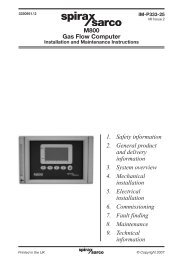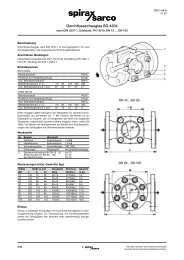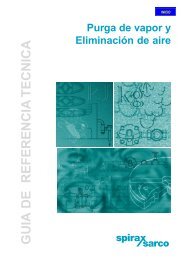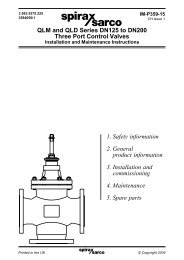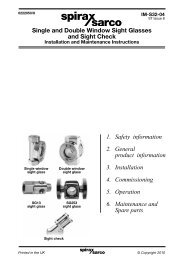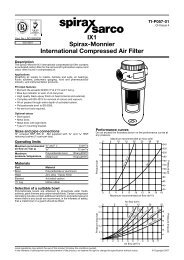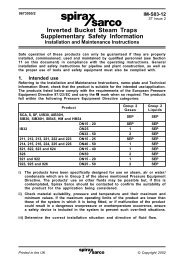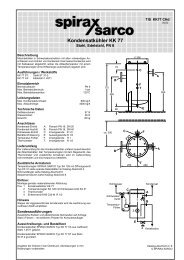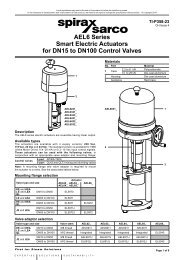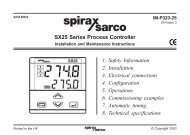2000 Hook-up Book - Spirax Sarco
2000 Hook-up Book - Spirax Sarco
2000 Hook-up Book - Spirax Sarco
You also want an ePaper? Increase the reach of your titles
YUMPU automatically turns print PDFs into web optimized ePapers that Google loves.
say seven (7) years. This means<br />
that after the first seven years of<br />
the life of the plant, in any year an<br />
average of almost 15% of the<br />
traps will fail. With an annual<br />
maintenance campaign, some of<br />
the traps will fail just after being<br />
checked and some just before the<br />
next check. On average, the 15%<br />
can be said to have failed for half<br />
the year, or 7-1/2% of traps failed<br />
for the whole year.<br />
Now, most of the traps in any<br />
installation, on the mains drip and<br />
tracer installations are probably<br />
1/2" or 3/4" size and most of them<br />
are oversized, perhaps by a factor<br />
of <strong>up</strong> to 10 or more. Let us assume<br />
that the condenste load is as high<br />
as 25% of the capacity of the trap.<br />
If the trap were to fail wide open,<br />
then some 75% of the valve orifice<br />
would be available for steam flow.<br />
The steam loss then averages<br />
75% of 7-1/2% of the steam flow<br />
capacity of the whole trap population,<br />
or about 5.62%.<br />
The steam flow through a<br />
wide open seat clearly depends<br />
on both pressure differentials and<br />
orifice sizes, and orifice sizes in a<br />
given size of trap such as 1/2"<br />
usually are reduced as the<br />
designed working pressure<br />
increases.<br />
Estimating Trap Steam Loss<br />
Steam loss through a failed open<br />
trap blowing to atmosphere can<br />
be determined from a variant of<br />
the Napier formula as follows:<br />
Steam Flow in lbs/hr =<br />
24.24 X Pa X D 2<br />
Where:<br />
Pa = Pressure in psi absolute<br />
D = Diameter of trap orifice<br />
in inches<br />
By multiplying the steam loss<br />
by hours of operation, steam cost<br />
(typically $6.00 per 1,000<br />
pounds), and by the number of<br />
failed traps, total cost of steam<br />
system loss may be estimated.<br />
The formula above should<br />
not be used to directly compare<br />
potential steam loss of one type<br />
Testing Steam Traps<br />
Table 17: Steam Flow through Orifices Discharging to Atmosphere<br />
Steam flow, lb/h, when steam gauge pressure is<br />
Diameter 2 5 10 15 25 50 75 100 125 150 200 250 300<br />
(inches) psi psi psi psi psi psi psi psi psi psi psi psi psi<br />
1/32 .31 .47 .58 .70 .94 1.53 2.12 2.7 3.3 3.9 5.1 6.3 7.4<br />
1/16 1.25 1.86 2.3 2.8 3.8 6.1 8.5 10.8 13.2 15.6 20.3 25.1 29.8<br />
3/32 2.81 4.20 5.3 6.3 8.45 13.8 19.1 24.4 29.7 35.1 45.7 56.4 67.0<br />
1/8 4.5 7.5 9.4 11.2 15.0 24.5 34.0 43.4 52.9 62.4 81.3 100 119<br />
5/32 7.8 11.7 14.6 17.6 23.5 38.3 53.1 67.9 82.7 97.4 127 156 186<br />
3/16 11.2 16.7 21.0 25.3 33.8 55.1 76.4 97.7 119 140 183 226 268<br />
7/32 15.3 22.9 28.7 34.4 46.0 75.0 104 133 162 191 249 307 365<br />
1/4 20.0 29.8 37.4 45.0 60.1 98.0 136 173 212 250 325 401 477<br />
9/32 25.2 37.8 47.4 56.9 76.1 124 172 220 268 316 412 507 603<br />
5/16 31.2 46.6 58.5 70.3 94.0 153 212 272 331 390 508 627 745<br />
11/32 37.7 56.4 70.7 85.1 114 185 257 329 400 472 615 758 901<br />
3/8 44.9 67.1 84.2 101 135 221 306 391 476 561 732 902 1073<br />
13/32 52.7 78.8 98.8 119 159 259 359 459 559 659 859 1059 1259<br />
7/16 61.1 91.4 115 138 184 300 416 532 648 764 996 1228 1460<br />
15/32 70.2 105 131 158 211 344 478 611 744 877 1144 1410 1676<br />
1/2 79.8 119 150 180 241 392 544 695 847 998 1301 1604 1907<br />
Figure 60<br />
Steam Trap Test Rig<br />
Pressure<br />
Reducing Valve<br />
Drain<br />
Pressure<br />
Gauge<br />
A<br />
Strainer<br />
C B<br />
D<br />
Spira-tec<br />
Loss<br />
Detector<br />
Drain<br />
Steam S<strong>up</strong>ply<br />
Test<br />
Trap<br />
To<br />
Atmosphere<br />
of trap against another because<br />
of differences in failure modes. In<br />
those that fail open only the<br />
inverted bucket trap orifice blows<br />
full open. Thermostatic types usually<br />
fail with their orifice at least<br />
partially obstructed by the valve,<br />
and flow through thermodynamic<br />
types is a function of many passageways<br />
and must be related to<br />
an equivalent pass area. In every<br />
case, no trap begins losing steam<br />
through wear or malfunction until<br />
Inexpensive test stand may be<br />
used to test steam trap operation.<br />
Valves A, B, C, and D are closed and<br />
the trap is attached. Valve C is<br />
cracked and valve D is slowly opened.<br />
The pressure-reducing valve is<br />
adjusted to the rated pressure of the<br />
trap being tested, valve C is closed,<br />
and valve A is opened slowly, allowing<br />
condensate flow to the trap until it is<br />
discharged. Valve B is then partially<br />
opened to allow the condensate to<br />
drain out, unloading the trap. Under<br />
this final condition, the trap must<br />
close with a tight shutoff. With some<br />
trap configurations, a small amount of<br />
condensate may remain downstream<br />
of the trap orifice. Slow evaporation of<br />
this condensate will cause small<br />
amounts of flash steam to flow from<br />
the discharge of the trap even though<br />
shutoff is absolute.<br />
the leakage area exceeds that<br />
needed by the condensate load.<br />
The cost then begins and reaches<br />
the maximum calculated only<br />
when the trap fails completely.<br />
The object is, of course to prevent<br />
it from reaching that stage. The<br />
steam system always functions<br />
best when traps are selected that<br />
are best for the application and<br />
checked on a regular basis to<br />
control losses.<br />
57<br />
SYSTEM DESIGN



